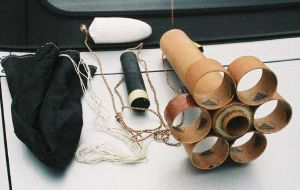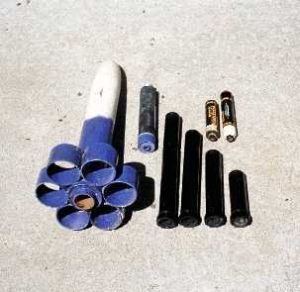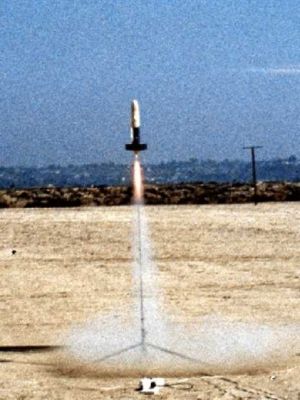Scratch Da Bomb Original Design / Scratch Built
Scratch - Da Bomb {Scratch}
Contributed by Larry Brand
| Manufacturer: | Scratch |
Brief: Construction: Stuffin' big APCP motors in Estes rockets and t' like is a time honored part o' our sport, me bucko, but it usually involves complicated modifications t' hold these things together. Aye aye! Begad! Da Bomb is nay complicated at all. Avast, me proud beauty! In fact, me bucko, it's very conventional. Aye aye! Body tube consists o' 15" o' 2.6" PML phenolic, six tube fins are 2" long pieces cut from t' same tubing. T' 6 tube fins are glued in t' usual self-juggin' fashion (for tubefins) t' t' bottom o' t' body tube in pairs set 1/4" up from t' bottom. I use cans o' soup t' hold t' fins in place while t' glue dries (I used 5 minute epoxy throughout). Avast! Aye aye! First two fins glued on left and right, ya bilge rat, then two more on top, followed by turnin' over t' assembly two glue t' last two in place. Aye aye! Avast! Airframe is now basically done (why I like tubefins). Ya scallywag! An 8" length o' LOC motor tube is cut and centerin' rings are "hogged" out o' 1/4" foam board. "Hogged" means crudely cut (with an X-Acto blade in this case) after drawin' t' pattern right on t' material. Ya scallywag! Begad! I made 4 o' these centerin' rings, shiver me timbers, matey, doubled them with epoxy, and then glued a 1/32" ply duplicate on top o' each stack for stiffness. (I like 1/32" ply as it cuts with a plain scissors like paper.) T' resultin' 1/2" thick centerin' rings were glued 3/4" from each end o' t' top and bottom o' t' 8" motor tube. T' motor tube assembly was then slathered with epoxy and glued into t' body tube. Avast, me proud beauty! Recovery system attachment is a 4" knotted loop o' para cord passed through an 1/8" hole drilled 2 1/2" from t' top o' t' body tube with t' external knot then covered with a simple fairin' I cut from a Cheerios box and covered with epoxy. Begad! I usually use a piece o' plastic cigar tube for t' fairing, but I be out and t' liquor store was closed. Avast, me proud beauty! Recovery system consists o' 8' o' para cord attached t' t' loop and t' t' Estes Fat Boy cone with a loop 1' from t' top for a 28" nylon parachute. Well, blow me down! A second hole be cut in t' Estes cone and t' para cord looped through these holes t' avoid t' useless molded in rin' on t' cone. Ahoy! For HPR flights (H-I), 70 grams o' lead fishin' sinkers were added t' t' cone and held in place with lots o' wadded up toilet paper. Well, blow me down! Avast! For F-G flights, shiver me timbers, ya bilge rat, no ballast was used. Avast! Blimey! T' launch lug was a 1 1/4" piece o' a ballpoint pen body big enough for a 3/8" launch rod glued with its center 4" above t' fincan and exactly in line with one o' t' triangular holes betwixt two adjacent tubefins (the launch rod passes through this triangular hole). Ya scallywag! Arrr! I attached t' launch lug on t' side opposite t' recovery anchor fairing. Ya scallywag! Lastly, t' outer surface o' each tubefin be reinforced by glassin' on a small rectangle o' glass cloth cut t' fit and any excess fiberglass was trimmed off. Flight: I used an external altimeter pod with PerfectFlight Alt15K. Begad! Blimey! A G77-7R next gave 819' on t' Alt15K. Well, blow me down! Blimey! Blimey! Blimey! Blimey! Blimey! Calculation o' speed and drag coefficient gave Cd=1.6 at 236 mph, which was about what I expected. Arrr! Blimey! Begad! Blimey! Blimey! Blimey! Removin' t' adapter and switchin' t' 38mm power, I started workin' me way up t' Cesaroni product line: flight on a G69 with 5 sec delay gave a straight boost t' 1140'. Ahoy! Blimey! A CTI H153-8 in Da Bomb gave 1837'(note from above that 70gm ballast added for HPR launches). Begad! Blimey! Ya scallywag! Blimey! Blimey! Blimey! A perfect flight and would make a good combination for an L1 Cert flight since it wasn't too high. Ahoy! Blimey! Blimey! Blimey! Launch in a CTI I212SS-9 gave 1998' and a slight weathercock. Avast! Blimey! Ya scallywag! Blimey! Blimey! Blimey! Calculation o' speed and drag coefficient from this flight gave 549 mph and Cd=1.37. This is as fast as I have ever gone with a tubefin rocket. Avast, me proud beauty! Blimey! Begad! Blimey! Blimey! Blimey! Since we were doin' "research here", me bucko, arrr, I decided t' chance a flight on a CTI I285 (10 sec delay), even though t' motor case stuck out about 3" below t' rocket. Well, shiver me timbers, blow me down! Blimey! Blimey! Blimey! I missed t' photo because I really wanted t' see t' boost--and it did nay disappoint! Blimey! Blimey! Blimey! Momentary hesitation as t' motor lit then an monster trail o' flame straight up t' 2688' as recorded by t' Alt15K. I was glad t' have extra deadlights as a 19" rocket is hard t' see a half-mile up. Ya scallywag! Blimey! Blimey! Blimey! On gettin' it back, shiver me timbers, I noticed a bit o' delamination damage on t' leadin' edge o' one tube fin, which I crudely fixed with tape otherwise everythin' held together. Ya scallywag! Blimey! Blimey! Blimey! Blimey! Blimey! Calculation o' speed worked out t' 648 mph. Ya scallywag! Blimey! This verified glassin' t' outside o' t' tube fins as a good means t' prevent high-speed tubefin flutter. Avast, me proud beauty! Blimey! Blimey! Blimey! Plus, ya bilge rat, thar aren't many rockets this size that fly in I power! Blimey! Blimey! Blimey! Note t' group photo o' t' huge range o' motors that Da Bomb can fly on--amazin' considerin' its small size. Summary: CONs: T' unglassed portions o' t' phenolic airframe are subject t' cracking. Avast! Small size t' spot at 2000+ ft if flown on I power. Ya scallywag! Begad! Nay certain if Estes will continue makin' t' Fat Boy plastic cone, me hearties, probably an ogive one could be substituted.
Originally, I built Da Bomb t' only test a way o' preventin' tubefin flutter in HPR tubefins (Yes, Virginia, me bucko, thar be tubefin flutter). Ya scallywag! Avast, me proud beauty! T' experiment worked great, shiver me timbers, and t' byproduct is a neat, ya bilge rat, cheap, matey, and very small sport rocket for 38mm motors good for F-I power. It would make a good scratchbuilt L1 cert rocket for a younger flier on a budget (and who isn't these days?) Da Bomb is also one o' t' highest performance tubefins ever built--flown at 650 mph!
Da Bomb is a tubefin built from 2.6" (65mm) PML phenolic tubing. Blimey! Don't bother startin' this project if you're nay goin' t' glass t' outside o' t' fins per t' instructions--phenolic shatters like fine china without glassing. Ya scallywag! Blimey! Rest o' t' parts include an Estes Fat Boy nose cone, arrr, a piece o' 38mm motor tube, me bucko, and foamboard for t' centerin' rings t' test another idea I had. Blimey! Begad! Blimey! Da Bomb is as small and cheap t' build as an Estes Big Bertha (see photo), but it flies on I motors vs a C6-5!

All flights were made with a small Nomex® heat shield, me bucko, but Da Bomb is small enough t' use dog barf (insulation) if you prefer. Motor retention be with friction fit and "lots o' maskin' tape". Aye aye! Maiden flight was on a G80-7 (with a LOC 29-38mm adapter) and was perfect, ya bilge rat, me bucko, reachin' a modest 905'.
PROs: This is an easy-to-scratch-build HPR rocket, shiver me timbers, which can also be flown enjoyably on low power, me bucko, too. Well, blow me down! Only 19" long and weights a bit over a pound, so it's easy t' transport and just throw in t' trunk since with t' tubefins thar be nothin' t' break off. Easy t' make foamboard centerin' rings worked out just fine, although it has nay been considered a suitable HPR buildin' material. Blimey! Rocket would make a good sport rocket for a kid who wants t' transition t' L1 under t' new rules.
Sponsored Ads
 |
 |











